Passengers on the Lilydale and Belgrave lines get the most express services of any line on the Melbourne rail network, thanks to the separate ‘express’ and ‘local’ tracks that run between Box Hill and the CBD. So what work would be needed to extend the track further east to Ringwood?
Some history
Originally built to serve the country towns of Ringwood, Ferntree Gully, Healesville and Warburton, the land boom days of the 1880s saw the line duplicated as far as Ringwood.
But it was the eastward spread of Melbourne’s suburbs after WW2 that led to construction of a third track far as Box Hill, to meet the demand for demand for peak hour express trains in the face of private car ownership. Vicsig.net has the opening dates:
- Hawthorn – Camberwell: 1963
- Camberwell – East Camberwell: 1964
- Richmond – Burnley: 1966
- East Camberwell – Box Hill: 1971
- Burnley – Hawthorn: 1972
And there work stopped, with the exception being the provision of a third platform at Blackburn in 1980, to permit trains to continue running while Box Hill station was rebuilt as part of the grade separation project.
A little future planning
In 2007 the railway line between Box Hill and Blackburn was lowered to remove a level crossing as part of the Middleborough Road Project. The railway cutting was built wide enough for a third track to run down the middle.
With Laburnum station also rebuilt for the future – two platforms flanking the widely spaced tracks.
And in 2010 another section of the line was rebuilt, as part of the Springvale Road Rail Project.
Nunawading station was rebuilt as an island platform, with a two track bridge beneath Springvale Road.
And a hard concrete wall along the northern side.
But the southern side was left open, ready to be dug out for a future third track.
Then down the trench
We’re now at 2014, and the Mitcham Level Crossing Removal Project has just been completed. The level crossings at Mitcham Road and Rooks Road were removed, but thanks to the tight rail corridor no provision was made for a third track.
The track weaves around at the bottom of a two track wide cutting.
With the rebuilt Mitcham station situated at the bottom of a similarly claustrophobic hole.
The Heatherdale level crossing removal project completed in 2017 continued this pattern – a long deep cutting.
And a pair of platforms flanking double track.
While the Blackburn Road level crossing removal project also completed in 2017 took things a step further – a double track bridge under Blackburn Road.
And a narrow two track cutting headed almost a kilometre towards Nunawading.
So what happened to the plans?
The local councils in the Eastern Transport Coalition want the track from Box Hill to Ringwood to be triplicated:
The Belgrave/Lilydale line, with approximately 93,000 daily boardings, is Melbourne’s most highly patronised rail line. Ringwood, 25.8 kilometres eastwards from Flinders Street, serves as a junction between the Belgrave and Lilydale lines.
Linking many of Melbourne’s main activity centres and growth areas, the Belgrave/Lilydale line is critical to ensuring liveable eastern suburbs and now is the time to expand the capacity and allow for future growth.
The line includes a third bi-directional track through to Box Hill. To facilitate more efficient travel, including the provision of express services at Ringwood, triplication over the 9.6km of track is required.
Public Transport Victoria also seem to be protecting the land required to build a third track, based on the Box Hill to Ringwood Bike Path Project design options report:
Impact on rail services: PTV’s requirement to not preclude the provision of a future third track cannot be compromised.
A key aspect of this route is that it cannot be built without stepping on the footprint of the future third track from Box Hill to Ringwood without acquisition of private land. If approval could be gained now to build the path, it would need to be removed in the future when the third track is built.
But the PTV Network Development Plan published in December 2012 fails to mention it – a fourth track between Burnley and Camberwell, and eventually Box Hill appearing instead:
16.5 Fourth track between Burnley and Camberwell
The connection of the Northern and Caulfield loops to each other will enable the creation of a new cross-town line linking the Burnley local lines (Glen Waverley and Alamein) to the Werribee line. This line will be segregated and will ultimately have a capacity of 24 trains per hour in each direction.
However the key constraint to achieving this frequency will be the three-track section between Burnley and Box Hill. During peak periods, in the peak direction, the outside line carries Burnley local services, while the centre track caters for Burnley express services.
In the counter-peak, a mixture of express and stopping services currently share the single track (although in order to maximise capacity on the counter-peak track, all trains need to stop at all stations).
This configuration means that the different train services are sectorised going in the peak direction; however, they must share one track in the counter-peak direction. As the capacity of the single counter-peak track is much less than the two peak direction tracks, the number of train movements in the peak direction is limited to avoid train congestion in the city during the morning peak. This means that some peak direction capacity cannot be used.
To overcome these issues, there is a need to quadruplicate the rail line between Burnley and Camberwell and ultimately onto Box Hill. This would involve the construction of a fourth track on the south side of the existing rail corridor, with new platforms at Camberwell. The third platform at all other intermediate stations would become redundant and could be demolished if required to make room for the fourth track.
But even that idea isn’t a new one – many underline bridge between Burnley and Camberwell have abutments ready built for a four track, constructed as part of the 1960s triplication work.
So what’s better?
Daniel Bowen asked the How many tracks? question back in 2016 – short answer is that for a modern metro service, four is better than three.
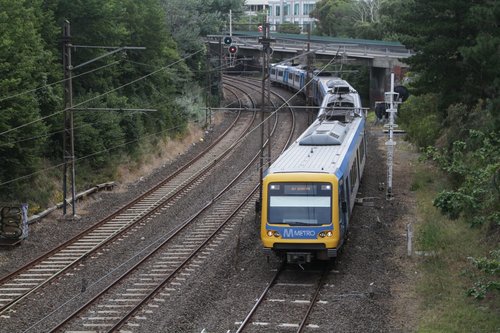
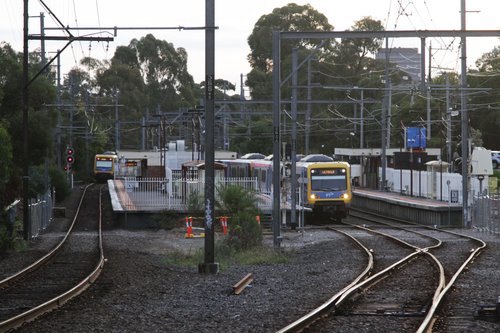
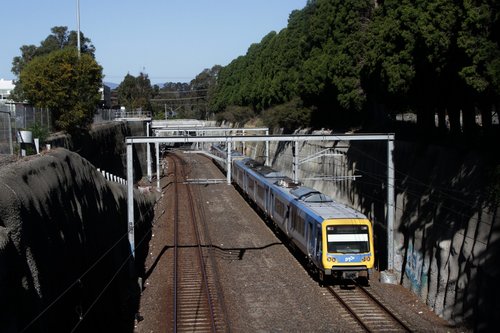
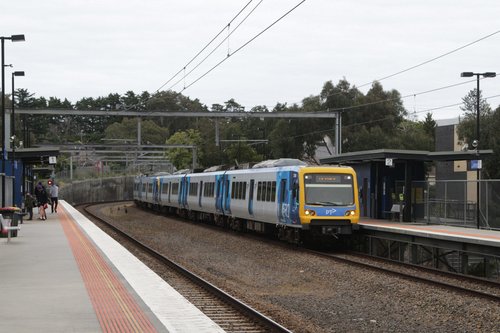
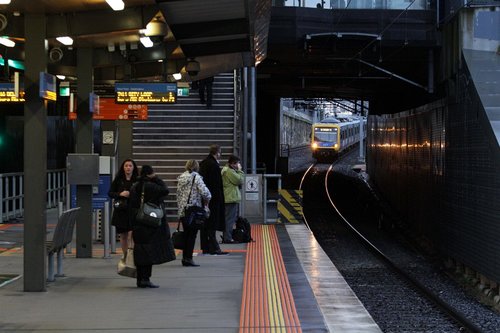
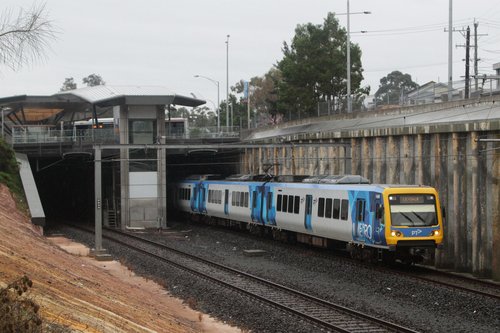
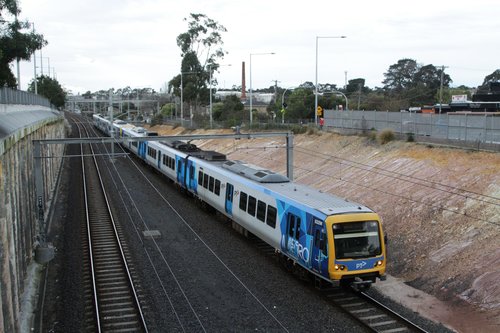
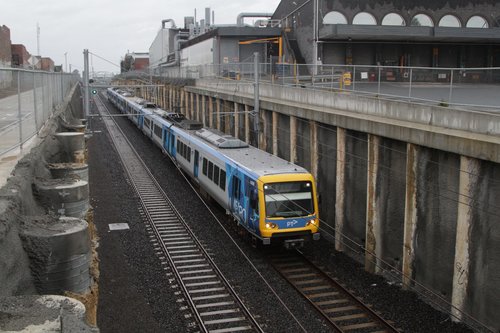
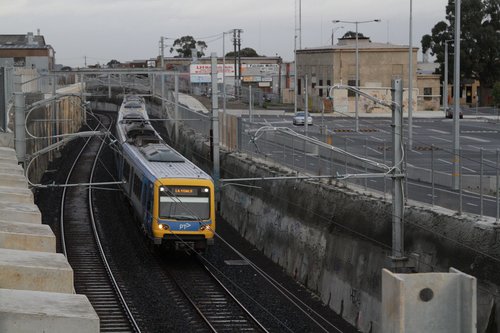
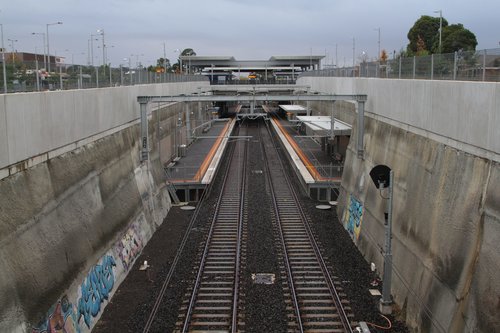
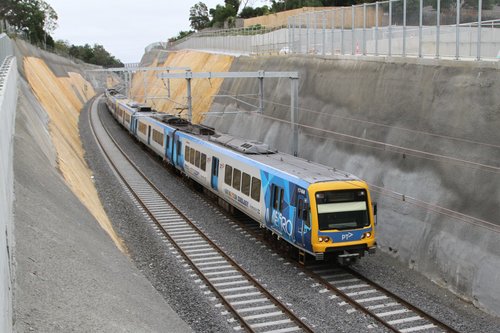
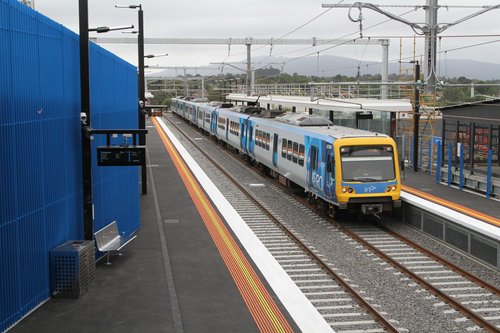
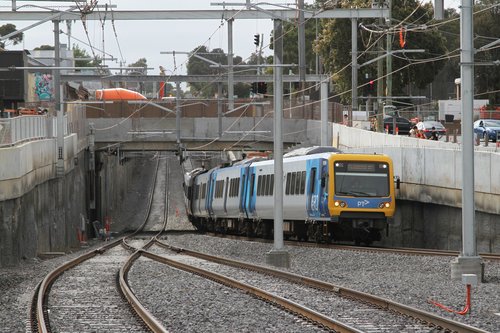
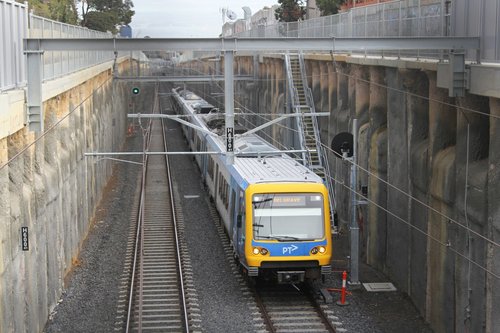
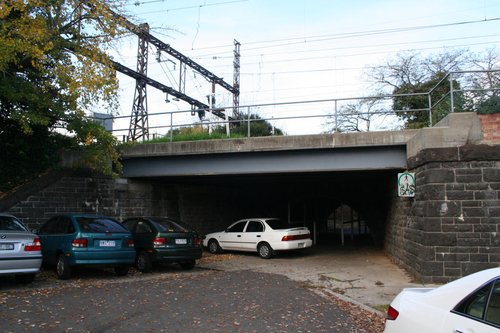

Four Tracks to Box Hill is immensely more useful.
City Loop trains can run express Richmond to Box Hill and stop all stations from there. If run every 6-7 minutes can be run in tandem with Glen Waverley trains (would need to rebuild Burnley flyover, but that would be the case anyway when the level crossing is removed).
Direct Flinders trains can run every 3-4 minutes between Richmond and Camberwell stopping all stations, with some running to Alamein and the rest running to Box Hill (stopping all stations).
Would provide the outer east with a consistent faster service whilst giving capacity to stations that otherwise see full trains in peak.
There is no “express” or “stopper” track from Box Hill-Burnley.
They are simply the Up, Centre, and Down lines – the only difference is the Centre line has a 5km/h faster max speed limit (70km/h vs 65km/h) which saves a grand total of a minute for Camberwell-Burnley and maybe 1:30 for Box Hill-Camberwell.
All three have both stopping and express services – the only real delineation is that peak-hour services use the Centre Line for express trains.
Four tracks Camberwell-Burnley might seem feasible if the research outside hitting Ctrl+C/Ctrl+V on various reports, referring to other self-appointed armchair experts like Daniel Bowen, and taking a picture is sufficient. Maybe have a closer look at the aligmnemt, especially between Glenferrie and Auburn – development in a solidly NIMBY area as well as any development for a fourth platform at Camberwell station and the massive outrage that will develop.
Not sure John S. understands that the frequencies proposed would only be improved for counter-peak running for quadruplication. As it is the frequencies are what he proposed.
As part of the level crossing removals due in Mont Albert and Surrey Hills, at least Surrey Hills will be rebuilt (almost certainly) to allow for quadruplication and that could mean locking in express and stopping platforms (to reduce platform construction costs and land footprint).
Much of the corridor Burnley-Camberwell already has space for 4 tracks. Hawthorn and Auburn don`t need additional platforms if the stoppers don`t use he 4th track. The corridor between Glenferrie and Auburn is wide enough, just, particularly if parts of it are converted from an embankment to skyrail. The tricky part is the 4th platform at Glenferrie, which may (due to straightness requirements) need to be built over Glenferrie Rd.
The number of peak direction services is limited by the number of counter-peak direction services because neither the city of Box Hill have the stabling to allow the third track to operate independently of the rest of the other lines, so quadruplication allows more trains to run in the peak direction. The Belgrave/Lilydale lines have very heavy counter-peak patronage because of all the major patronage generators on the line (Swinburne at Glenferrie and office precincts at East Richmond, Camberwell and Box Hill), justifying a significant counter-peak service.
The rail corridor is tight as you say – this laneway backs right onto the tracks.
And the retaining wall built as part of the 1970s grade separation at Elgar Road is right on top of back fences.
The extra platform at Camberwell can go where the yard is now. There is plenty of room between Camberwell and Burnley for four tracks, provided that the upgrade is designed so that the outer pair of tracks are designated as Express tracks (no platforms needed) and the inner pair become Local tracks. From Camberwell to Box Hill it’s a bit more awkward, and the additional track would have to sometimes go to the north and sometimes to the south, but it’ll fit. The best approach would be to combine that with grade separation of the two remaining level crossings and bury the line between Mont Albert and Chatham, combining Mont Albert with Surrey Hills as the two stations are quite close together.
Melbourne’s rail infrastructure is held back by four things:
– a lack of an innovative and competent public sector that is willing to look at best practices from overseas (particulary non-English speaking countries like Switzerland)
– a refusal to use more flexible track geometry (e.g. curved turnouts) and bidirectional signalling
– a lack of political will to just get the job done already
– a mass media organisation that criticises any kind of expenditure on the public good, churning out fear-mongering headlines and buzzwords that sway public opinion into NIMBY-ism
Converting three platforms and three tracks into four tracks with just two platforms looks to be the only way you’d squeeze through the likes of Glenferrie and Auburn – good luck with building over the top of the existing shops though!
Hawthorn, Glenferrie and Auburn can all accommodate the 4th track without demolishing the existing stations as Hawthorn had a station yard and space hwas been left for the track when the rest of the yard land was sold off and Glenferrie and Auburn were designed for 4 tracks. The biggest problem is getting a modern straight platform at Glenferrie, where most expresses stop because of Swinburne and the major shopping strip, it might require building the platform over Glenferrie Rd.
But surely three is better than two ? At least you get expresses in the peak direction. I grew up at East Camberwell, the expresses meant i could get to Melb uni in half an hour ! sometimes. surprised to learn that the third track was so recent, assumed always there. I do think that we are lucky to have third or fourth tracks at all – cities with metro systems are stuck with two, except it seems in New York where some lines were built with three or four tracks, but then they often have ‘commuter trains’ which would i guess be as if for instance dandenong and on to warragul had its own lines into the city.
Three is better than two, but if you are spending $$$ on land acquisition to build an extra track, adding a fourth one is only twice the price. 😛
Until the early-2000s it was proposed to just build a third track between Footscray and Sunshine – it took the idea to turn into ‘Regional Rail Link’ for it to gain a fourth:
https://wongm.com/2014/01/regional-rail-link-precursor-plans/
Rohan, I gather that question is more around the issue of what should be a priority – extending a third track to Ringwood, or quadding to Camberwell (or Box Hill). I would think the latter gives you more bang for buck (granted probably more complex public acquisition to the former though)
Ringwood got a third platform in 1999.
https://vicsig.net/infrastructure/location/Ringwood
A curious omission – instead the station had a third track between the platforms, and a through siding on the southern side.
https://www.victorianrailways.net/signaling/completedia/blaringdia.html
There does not seem to have been a consistent policy on third platforms at junctions on double line in Victoria. Clifton Hill and Newport have never had them, despite being some of the busiest junctions, but some rural branch junctions on the Bendigo and Seymour lines did.
Sounds like if the branch line was run as a shuttle and the mainline was busy, a third platform was provided, otherwise just two platforms?
Newport is a possible exception to this, but it did have the Altona turnback sidings at the up end.
To be honest, express services do absolutely nothing but reduce total passenger numbers on the line. I completely understand why people want an express service. It makes sense to an individuals personal needs. But, express services reduce the number of people who can use the service over running a stopping all stations service.
When you go to 3 track over 2 track, you don’t make the situation any better, because the same trains need to converge somewhere. And they converge in the city, where lines all connect together. In order to increase total throughput, what we need is a replacement of the city loop bottleneck with metro style services, similar to the north south tunnel. We need more tunnels like this, and we need it now.
There is the possibility of converting the 4 tracks that run around the loop to a metro style rail network. Essentially, the only way to fix the network is to have trains from one side of the city, connecting out to the other side. Loop services need to be dismantled completely. And that is a controversial idea, one that no government would touch. The rail network delivered better capacity prior to the city loop then after it.
Stage 4 of the 2012 PTV Network Development Plan reconfigured Northern and Caulfield loops as a through pathway across the city:
https://static.ptv.vic.gov.au/siteassets/PTV/PTV%20docs/Metro-rail-network-development-plan/PTV_Network-Development-Plan_Metropolitan-Rail_Overview_2016update.pdf
And this 2018 plan added the through routing of the Clifton Hill and Burnley loops:
https://www.danielbowen.com/2018/10/17/rail-plan-leaked/
As for the capacity constraints – it doesn’t really matter if you are ‘throwing away’ track capacity by running express and stopping trains, if there aren’t more passengers waiting to use the trains. That applied back in the 1990s, but not so much today.
[…] Lilydale and Belgrave share a third track as far as Box Hill, allowing express trains to overtake all stations […]
Once they do the Level Crossings at Mont Albert and Surrey Hills the option of fourth track is obvious.
Knowing the Level Crossing Removal Authority it’ll be a three track wide trench with three platform stations, and no room for expansion.
That’s exactly what they’re doing. A few people have asked questions about future quadruplication, and they’ve stated that adding space for a fourth track would require property acquisitions, so it’s not needed. They’re so afraid of NIMBYism and the Sun Herald they’re throwing out the PTV Network Development Plan.
[…] The third platform at Ringwood – that didn’t happen until 1999. And a third track from Box Hill to Ringwood – the Middleborough Road Project of 2007 left space for it, but subsequent upgrades have kicked the idea off into the never-never. […]
I still think you could pull it off getting a third track to Ringwood with existing infrastructure. The nunawadding reservation is the most important one, being located almost exactly halfway between Box Hill and Ringwood. I am imagining an overpass track to the side, only for the Nunawadding stretch, such that a staggered timetable of local/express sees the Local train arrive at Nunawadding as the express overtakes it. Since the cadence between trains will remain at about 3 minutes, they naturally catch up to each other in either direction around Nunawadding. The tangle of tracks and signals, especially in evening peak, to have the express train cross the inbound tracks, is very not ideal, but that sort of dance will always be inevitable with some express lines located in the middle (East Richmond, Laburnum) and some located at the edges (Glenferrie). An overtaking lane, with some serious timetable re-jigging, would give close to triplicated services, on the morning schedule at least!